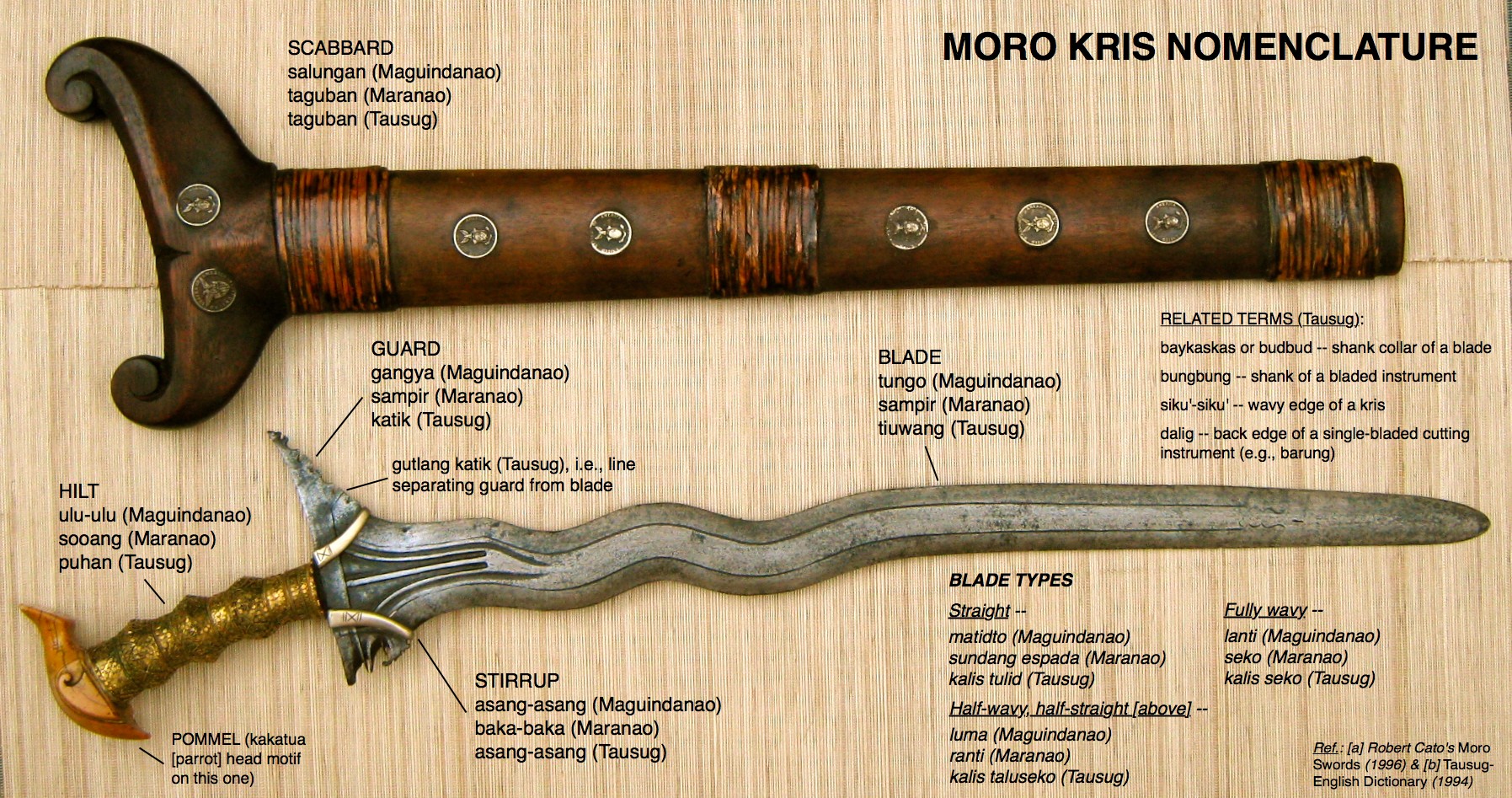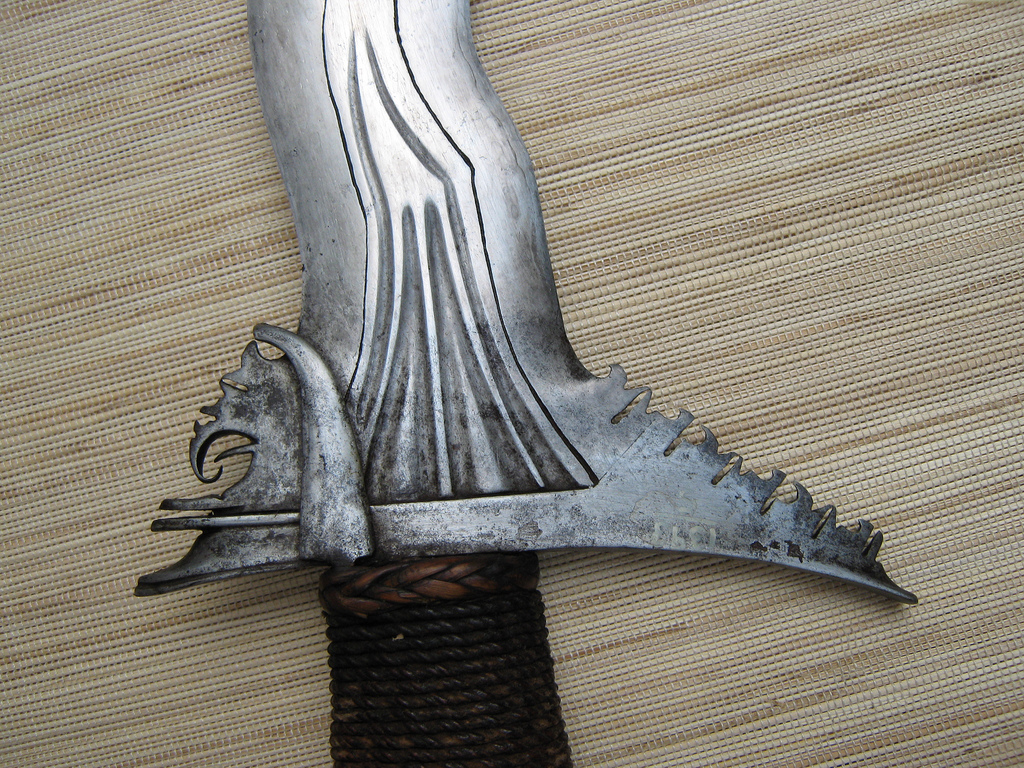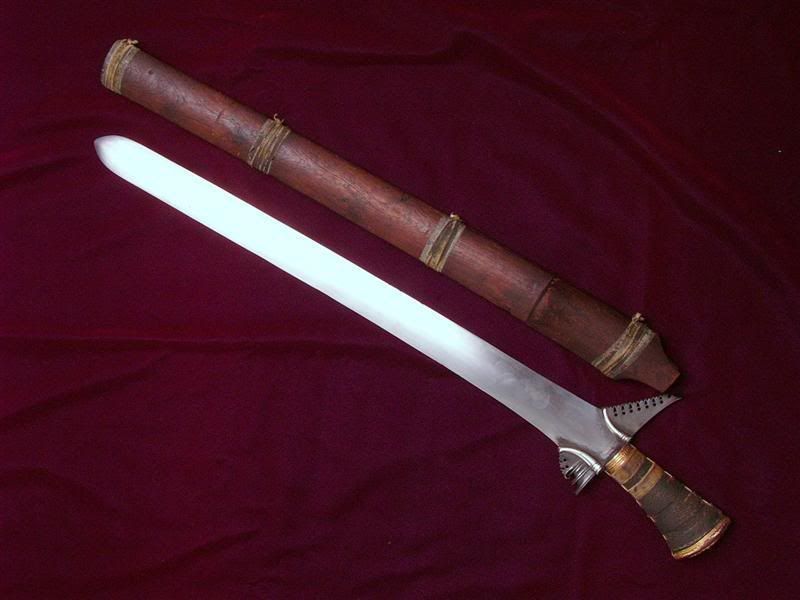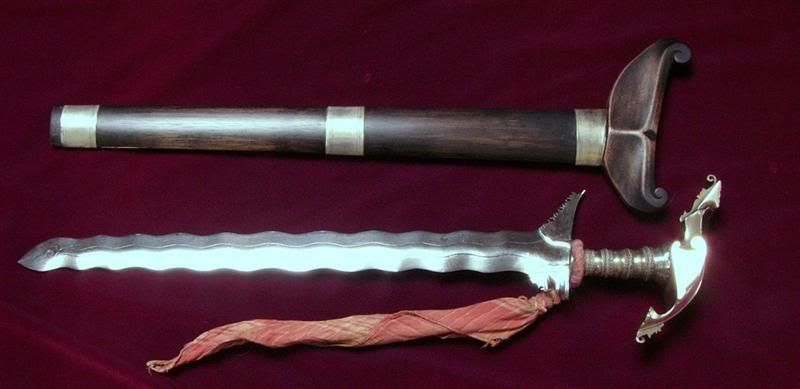Malaya Flag Proposals 1947-1949 (Malaysia)
People's Flag, 1947
image by
Hairul Hisham, 6 June 2008
The People's Flag was officially used all over Malaya since 10 Dec 1947. According to Utusan Melayu newspaper, almost all big towns and small towns including Malacca, Johor Bahru, Kuantan, Sungai Siput, Alor Stra and Singapore had a flag ceremony.
The meaning of the symbol on the People's Flag is:
12 stars - 12 states in Malaya, i.e., 9 Malay states + 3 Straits Settlements (Perak, Selangor, Negeri Sembilan, Pahang, Terengganu, Perlis, Kelantan, Kedah, Johor + Pulau Pinang, Melaka, Singapura).
Yellow Color on Star - People's justice and sovereignty, constitution approved, imagine all states in peace and prosperity.
Five sided on the star - God, people's sovereignty, social justice, welfare, nationhood.
Red color - The peoples' bravery and power for the challenge; facing all obstacles; resistance in order to create justice and democracy in Malaya
White color - Struggle based on honesty and purity to obtain true freedom without any greed and bribery, but only with one ambition, i.e., our own government based on People's Sovereignty
Also: the red-white color represents Malaya's peoples and was chosen by PUETRA and AMCJA (both after Japanese Occupation resistance) because it is the Malay national flag color since Majapahit on 14th century (Same as the
Indonesia flag.)
Adapted from :
10tahun.blogspot.com
Hairul Hisham, 6 June 2008
Flag Proposals 1949
Document, BT 11/4189, in the Public Record Office at Kew explains some of the thinking behind the design of the
Malaysian Flag.
Federation of Malaya Order No.61 of 1949 announced that a committee had been set up to make recommendations for the design of a Federation Flag. A competition was organised with the suggestion that, in any design submitted, the flag should be simple, and have not more than four colours, which might perhaps be yellow, red, white and blue, the colours most frequently used in the flags of the nine states and two settlements of the federation. Suitable symbols would include the kris (a Malayan sword), tiger, and crescent.
A total of 373 entries were received. The committee chose three to put before the Legislative Council:
image by Eugene Ipavec, 7 September 2007
In the centre of a blue flag, two crossed red kris, surrounded by a circle of eleven white five pointed stars. (Crossed kris can be seen behind the anchor on the
Malaysian naval ensign).
Explanation. Colours; red was found on six state/settlement flags, white on five, and blue on three, and all were colours of the
Union Jack. Eleven stars of equal size, equally spaced, represented the states/settlements in no particular order, and each of equal importance. Kris was of great antiquity and peculiar to the Malayan archipelago, thus identifying the flag with Malaya.
image by
Eugene Ipavec, 7 September 2007
Similar to the first proposal, but with the stars arranged in two concentric circles, one of six stars, outside one of five stars.
Explanation. The same as first proposal, with the inner circle of stars representing the Unfederated Malay States and the outer circle the four Federated States and two Settlements.
image by
Eugene Ipavec, 21 October 2007
Six blue and five white horizontal stripes. A red canton half the length of the flag resting on top of the white stripe second from the bottom. A yellow five point star, oriented with one point in the six o'clock position, in the centre of the canton, and a yellow crescent, arranged like a C, between the star and the hoist.
Explanation. One stripe for each state or settlement. Yellow star and crescent represented sultanate monarchies of the states, and the religion of the states. The red field of the canton represented British protection and the complete red, white, blue associated the Federation with the Commonwealth.
image by
Eugene Ipavec, 21 October 2007
Same as the third proposal, but with crossed kris instead of the crescent and star.
The newspaper Malay Mail published the designs and organised a poll. 42 percent favoured the third proposal, 27 percent wanted the fourth, with kris instead of the crescent and star, and 25 percent wanted a
Union Jackincluded.
On 6 March 1950 the Federal Legislative Council decided that none of the designs were acceptable, and asked for a revised design that would be considered on 19 April. At this meeting the Council approved a
revised version of (3) in which, the blue stripes were replaced by red stripes, the red canton was replaced by a blue canton, and the five point star was replaced by an eleven point star.
According to I.O. Evans writing in 1953 [
eva57];
Its colours combine the traditional royal hue, gold, of the Sultans of Malaya with the red, white and blue of Britain; the eleven stripes and points on the star indicate that number of states in the Federation; the crescent and star form the traditional Mohammedan emblem.
The company producing the first batch of flags questioned the width of the canton, which was 7 stripes deep, when it could be 6 stripes deep and still more than half the width of the flag. The answer was that the stripes represented the unity of the states and settlements, and it was hoped that
Singapore would join the Federation when an additional white stripe would be added to the bottom of the flag.
David Prothero, 2 May 2002
1:2 image by
Clay Moss, 15 September 2006
Description
In 1950 a new flag was introduced: the basic design is that preserved in the
modern flag, but 11 stripes and an 11-pointed star, representing the number of constituent states. In 1963 three more states (Sabah, Sarawak, and Singapore) joined the federation and country's name changed to Malaysia. The common explanation for the addition of the 's' in the name is that all three new states start with this letter. The number of stripes on the flag was increased to 14 as was the numbers of points on the star.
The flag of Malaysia is a combination of traditional Islamic symbols and the Stars and Stripes. The 14 stripes and the 14 points of the star represents the 14 member states and the crescent and star represents the dominant religion Islam. The blue canton stands for affiliation to the Commonwealth. The dimension of the flag is 1:2.
Jan Oskar Engene, 24 June 1996
The
old Malayan (for the Federation of Malaya) flag was similar to the
present day Malaysian flag except that the star and the stripes were 11 for the 11 states of Peninsular (or West) Malaysia. The flag was changed with the creation of
Malaysia in 1963.
Thomas W. Koh, 14 May 1997
[Translated from the Malaysian flags official URL:]
History of the FlagThe flag was chosen by a body established in 1949 to choose a flag for the Federation of Malaya. A competition was held by the Federal Legislative Assembly, in which 373 entries were submitted of which 3 made it to the final stage. The first design was a badge of crossed kris circled with 11 five-pointed stars. The second design was similar to the first, except that the 11 stars were arranged in two circles around the crossed kris. The third design was 11 blue and white stripes with a yellow moon and star at the hoist.
The Malay Mail surveyed public opinion, and on 28/11/49 published the result, i.e. a majority for the third design, the creation of a government architect from Johore, En. Mohd b. Hamzah.
With a few amendments the flag attained the support of the Council of Rulers on 22/2/50 and on 19/4/50 the Federal LegCo passed a motion That in the opinion of this Council the Flag of the Federation of Malaya should be as follows:- Eleven horizontal stripes alternately red and white in colour, the uppermost stripe being red, having a blue quarter with a crescent and eleven-pointed star in yellow superimposed, the standard size of the flag to be six feet by three feet.
The design was approved by HM King George VI on 19/5/50, and the flag was first flown at a flag-raising ceremony held by the British High Commisisoner on 26/5/50 in the compound of the Sultan of Selangor's palace, attended by TH the Rulers of the Malay States and British officials.
Andrew Yong, 15 August 1999
Flag used at the 1950 British Empire Games
1:2
by
António Martins and
Dean Thomas
The flag shown here is a
Union Flag defaced with the word 'MALAYA'. This flag was used by the Malaya team at the 1950 British Empire Games in Auckland,
New Zealand.
Dean Thomas, 15 August 1999
Malaysia
1:2

image by
Clay Moss, 6 January 2006
Flag adopted 16th September 1963
Description
I came across an official Malaysian Year Book in my local library and it had 'official' descriptions of the Malaysian national and state flags as well as description of armorial ensigns, state emblems and other information like state anthems, history, rulers (as in 'sultans') etc.
The Malaysian National Flag consists of fourteen red and white stripes (along the fly) of equal width, a union or canton of dark blue, a crescent and a star. The red and white stripes stand for equal status in the federation of the member states and the federal government. The union or canton of dark blue represents the unity of the peoples of Malaysia. The union contains the crescent which is the symbol of Islam, and the star, the 14 points of which symbolise the unity of the 13 states of the federation with the federal government. The yellow of the crescent and the star is the royal colour of the Rulers.
Thomas W. Koh, 14 May 1997
The 14 stripes on the Malaysian flag represent the 14 states of Malaysia (Perlis, Kedah, Perak, Kelantan, Terengganu, Pahang, Johor, Malacca, Negri Sembilan, Selangor, Penang, Sabah, Sarawak and the Federal Territories of Kuala Lumpur and Labuan). The blue square represents the harmony of the people. The crescent symbolises Islam, the national religion and the colour yellow is the colour of royalty.
Giuseppe Bottasini, 13 August 1997
[Translated from the Malaysian flags official URL:]
The dark blue stands for the unity of the Malaysian people. The crescent moon is a symbol of the official religion Islam. The 14 pointed star symbolises the unity of the 13 states and the federal government. The yellow is the colour of Their Highnesses the Rulers of the Malay States.
The rules for flying flags seem to be the same as in the UK, etc, except that in Malaysia state flags are flown in the honour position at state events and on state holidays. Also, the order of state flags is according to the precedence of their Rulers, which is according to seniority, sultans/rajas then governors.
Andrew Yong, 15 August 1999Regarding the origin of the flag, I may not have the exact citation but growing up in Malaysia, the sporadic pieces of information on the origin of our national flag has seeped into our psyche. Here are some well know facts that may help explain why the uncanny resemblance to the
Stars and Stripes:
- Malaysia is a federation of previously independent states (not autonomous)
- We are one of a handful states in the work that is constituted based on a federation model (like India, Australia, Canada, US)
- Therefore, our founding fathers drew their inspiration from a handful of existing models at that time:
o India has no element of "unity of elements" in its flag
o Australia and Canada (old flag, pre '64) is too British with the Union Jack in it
o The US was the post war hero, liberators and role model to the world on many fronts with a great federalist flag.
The Stars and Stripes was a natural choice. Similar themes where adhered to:
- Each stripe represents one of the states (grew from 11 to 14)
- The star has 14 pointed tips The symbol of equality and strength in unity is reflected in its design.
CW Wong, 8 August 2007
Origins of the Flag
Smith 1980 [
smi80] says,
"Blue was chosen for the Malaysian flag to show its association with the Commonwealth (...)". Pedersen 1971 [
ped71] is more specific,
"Dark blue is from the British flag and symbolizes the connexion with the Commonwealth". I noticed that two recent books, Dorling-Kindersley 1997 [
udk97] and Znamierowski 1999 [
zna99], have dropped the connection with the
Commonwealth. I would not be surprised if the change in the 'meaning' of the blue colour were associated with the accession of Mahathir Muhamad to the power in July 1981. Mahathir has developed a nationalistic ideology and would like to be the 'champion' of South-East Asia. This could explain that the reference to the British Commonwealth was discarded.
Ivan Sache, 23 April 2002
Document, BT 11/4189, in the Public Record Office at Kew explains some of the thinking behind the design of the Malaysian Flag. Federation of Malaya Order No.61 of 1949 announced that a committee had been set up to make
recommendations for the design of a Federation Flag. (...)
David Prothero, 2 May 2002
The colour blue on the flag may have represented the Commonwealth originally, but this is not the case now. Blue symbolises unity or
perpaduan in Malay.
Nagathisen Katahenggam, 25 August 2002
Malaysia is a federation of monarchies and a member of the (British)
Commonwealth. The use of red and white stripes to represent a federation is clearly a
United States innovation, but early U.S. flag designers probably got the idea of red and white stripes from the flag of the British
East India Company, whose ships were frequently seen in American ports. The
Straits Settlements were an East India Company protectorate, and I suspect that the stripes on the Malaysian flag make reference to both their federation and their history with the East India Company.
Jonathan Makepeace, 15 January 2003
The derivation of the
US flag from the
East India Company flag is widely posited but also disputed. It is, as I understand it, not true that East India Company ships were frequently seen in American ports, at least not flying the
'gridiron' flag. Also, the Straits Settlements did fall under the East India Company, but not after the company was dissolved in 1858, 105 years before the Malaysian flag was adopted. Absent any legislative history supporting this theory, it seems to me less persuasive than the hypothetical connection to the Stars and Stripes.
Joseph McMillan, 15 January 2003
The very construction of the Malaysian flag, with its much larger blue canton [cf. the
Johore war ensign], is virtually a denial of
US influence. Whether the red-and-white stripes in the Malaysian flag can be derived from the
East India Company is a moot point, but the popularity of red and white in the East Indies (Malaysia and
Indonesia [cf. for instance the
Indonesian jack]) predates any influence on the part of either Britain or the United States. Red and white are part of the traditional colours of the
Malagasy people, too, remember — a people whose origins are in Borneo.
Mike Oettle, 19 January 2003
The founding fathers of Malaysia definitely had no reason to imitate the US flag. To find out the reason for the design of Malaysian flags, we have to check on the political history of Malaysia at the time of the independence. Malaysian politics till today comprises three distinct political parties each representing the 3 ethnic races of Malaysia - Malays, Chinese and Indians:
UMNO: United Malay National Organisation -represent the Malays
MCA: Malaysian Chinese Association-represent the Chinese
MIC: Malaysian Indian Congress -represent the Indians
The flags of the MCA is blue field with a yellow sun. The MIC flag is red and white stripe with MIC in Tamil and English at the centre. Now merge these two flags - the MCA flag on the canton and the MIC flags without the blue stripes on the fly. The crescent moon on the canton represent Islam hence the Malays.
Nadarajan V, 1 June 2009
At a Penang state track and field meet was last week I met an elderly gentleman (Mr. Ibrihim). He introduced himself and then began to ask questions about me...and after a while, he pointed to a Malaysian flag and asked me if the flag made me feel "at home" in any way. He then said that he was asking the question from a flag similarity standpoint. Surprisingly, he then said; "We intentionally copied the American flag you know." I said; "Really? How so?"
He said that in those days, there was a good deal of positive sentiment about the US and that the newly independent Malaya wanted to mimic the US form of government in as many ways as possible. They wanted to draft a constitution that was similar to that of the US and they were hopeful that they would develop as a nation as successfully as America had. Additionally, he said that the Malay were grateful for US intervention during WW II while also quietly encouraging the British to "let go" after the war ended. He said that the US flag serving as inspiration for the design of Malaya's flag was a natural sort of process and simply seemed like "the way to go." I was amazed that I was getting to listen to Mr. Ibrihim's story and asked him how he knew all of this. He then let me know that he had been a Malay state representative from Penang during and right after independence came along.
About that time, I had to excuse myself and said that I would return in a few minutes. When I got back to my seat, Mr. Ibrihim was gone. I never got to probe further relative to his story. I hope to track Mr. Ibrihim down soon.
Clay Moss, 11 April 2010
Name of the Flag: Jalur Gemilang
The Flag Bulletin [
tfb], #186, March-April 1999, page 74, says under the heading "Flag News and Notes" [
smi99e]:
Malaysia: The government of Prime Minister Datuk Seri Dr. Mahathir Mohamad has introduced many changes into the economic, political and social systems of Malaysia. On the 40th anniversary of the country's independence, 31 August 1997, provision was made for an official name for the national flag. The version chosen, Jalur Gemilang, combines a Malay word meaning "stripes" or "range of values" with the adjective ("gemilang") signifying "glorious". No change was introduced in the design of the flag.
Santiago Dotor, 20 December 1999
image by
Eugene Ipavec, 14 July 2005
A vertical, swallow-tailed Malaysian flag was shown in a TV documentary. I don't know how official it is, but it was hanging outside the Petronas Towers--a position of that visibility may mean something.
Eugene Ipavec, 14 July 2005
image by
Clay Moss, 6 January 2006
Sometimes seen is a typical Malysian national flag, except that the bottom white stripe wis abnormally wide, perhaps twice as wide as the others, maybe a bit less.
Jorge Candeias, 20 June 2009
There are lots of those type Malaysian flags flying here and there. They are printed cotton broad cloth and come in all sizes. Whoever makes/made them will simply get their screens a bit too narrow for whatever width they are trying to print. Usually the manufacturer is working with a piece of material that is pre-woven with tapered locked edges. That way, the flags do not have to be hemmed on the top or bottom. So, all they do is print, hem the fly and hoist and sell.
Clay Moss, 21 June 2009
Flags in Malaysia
Malaysia is really a good place for flag spotting. Flags are almost all over the place and not only the Malaysian flag but also all 14 states flags. People put little flags on their cars or inside their cars, they also use stickers with Malaysian flag and inscription 'Proud to be Malaysian' and so on. If you visit
Kuala Lumpur you must go to the Merdeka Square and see
one of the tallest flag poles in the world (100 metres). The Union Jack was lowered at midnight on August 30, 1957 and the Malayan flag hoisted up for the first time. It is really magnificent. There are Malaysian and
Federal Territory flags in front of the court building and all 14 states flags under the huge pole. The flag is really big and it's really great when you see it from different parts of the city. Here is a
little picture of the Merdeka Square with the tall flag pole.
Uros Zizmund, 25 July 1999
I found this flag related news in the East Malaysian
Daily Express online version 13 April 2001:
Kota Kinabalu: Fifty-eight students from Universiti Putra Malaysia (UPM) 10th College and Kolej Ibukota Kinabalu (KIK) fought coldness and fatigue to unveil Malaysia's largest Jalur Gemilang (national flag) on the summit of Mt Kinabalu last week. On Thursday, they once again unveiled the 118m x 77m flag at the KIK main campus football field in an attempt to enter the Malaysia Book of Records.Organised by the UPM 10th College undergraduate supreme council in collaboration with KIK, as the main sponsor, the project cost some RM20,000 and it took the students four months to prepare the flag. (...)
Strange dimensions, 118m x 77m, giving a proportion of (almost exactly) 13:20, as opposed to the official ratio of 1:2.
Santiago Dotor, 16 April 2001
![[Malaysia 1947 people's flag]](http://www.fotw.net/images/m/my-rakyat47.gif)
![[Malaysia 1949 proposal]](http://www.fotw.net/images/m/my!1949a.gif)
![[Malaysia 1949 proposal]](http://www.fotw.net/images/m/my!1949b.gif)
![[Malaysia 1949 proposal]](http://www.fotw.net/images/m/my!1949c.gif)
![[Malaysia 1949 proposal]](http://www.fotw.net/images/m/my!1949d.gif)
![[Federation of Malaya 1950-1963 (Malaysia)]](http://www.fotw.net/images/m/my1950.gif)
![[Flag used at the 1950 British Empire Games (Federation of Malaya 1950-1963, Malaysia)]](http://www.fotw.net/images/m/my1950_g.gif)
![[Malaysia]](http://www.fotw.net/images/m/my.gif)

![[Malaysia - vertical flag]](http://www.fotw.net/images/m/my_vert.gif)
![[Malaysia - 2:3 variant]](http://www.fotw.net/images/m/my-23.gif)




![[image] [image]](http://img.photobucket.com/albums/v25/Sakamaku/dls4_09a.jpg)
![[image] [image]](http://img.photobucket.com/albums/v25/Sakamaku/dls4_09b.jpg)
![[image] [image]](http://img.photobucket.com/albums/v25/Sakamaku/dls4_09c.jpg)
![[image] [image]](http://img.photobucket.com/albums/v25/Sakamaku/dls4_09d.jpg)
![[image] [image]](http://img.photobucket.com/albums/v25/Sakamaku/IMG_1486.jpg)
![[image] [image]](http://img.photobucket.com/albums/v25/Sakamaku/IMG_1502.jpg)
![[image] [image]](http://img.photobucket.com/albums/v25/Sakamaku/IMG_1505.jpg)

![[image] [image]](http://i206.photobucket.com/albums/bb114/Bill_Marsh/Kris%20etc%20Ramanon/CatoHH1.jpg)
![[image] [image]](http://i206.photobucket.com/albums/bb114/Bill_Marsh/Kris%20etc%20Ramanon/CatoHH.jpg)
![[image] [image]](http://i206.photobucket.com/albums/bb114/Bill_Marsh/Kris%20etc%20Ramanon/Danagan.jpg)
![[image] [image]](http://i206.photobucket.com/albums/bb114/Bill_Marsh/Kris%20etc%20Ramanon/Danagan1.jpg)
![[image] [image]](http://i206.photobucket.com/albums/bb114/Bill_Marsh/Kris%20etc%20Ramanon/Sultan.jpg)
![[image] [image]](http://i206.photobucket.com/albums/bb114/Bill_Marsh/Kris%20etc%20Ramanon/Sultan1.jpg)
![[image] [image]](http://i206.photobucket.com/albums/bb114/Bill_Marsh/Kris%20etc%20Ramanon/15813Medium.jpg)
![[image] [image]](http://i206.photobucket.com/albums/bb114/Bill_Marsh/Kris%20etc%20Ramanon/15817Medium.jpg)

![[image] [image]](http://i206.photobucket.com/albums/bb114/Bill_Marsh/Kris%20etc%20Ramanon/P1040525Medium.jpg)
![[image] [image]](http://i206.photobucket.com/albums/bb114/Bill_Marsh/Kris%20etc%20Ramanon/P1040532Medium.jpg)
![[image] [image]](http://i206.photobucket.com/albums/bb114/Bill_Marsh/Kris%20etc%20Ramanon/hitman1Medium.jpg)

